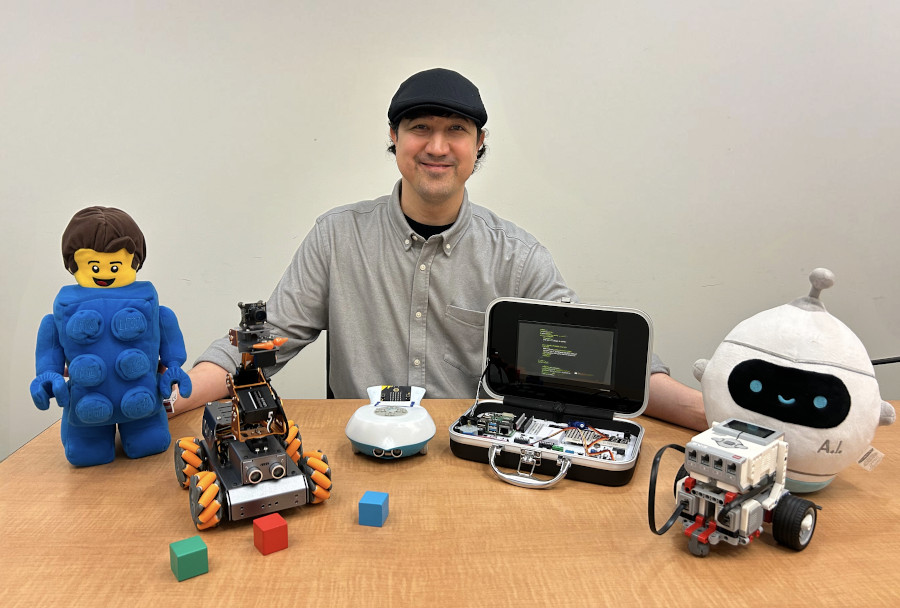College of Education and Human Development
School of Education’s Erdogan Kaya is Awarded NSF Grant in Support of Project Focused on Introducing Linguistically Diverse Elementary Students to AI and Machine Learning
January 6, 2025
Erdogan Kaya, assistant professor in the Elementary Education and Secondary Education Programs within the School of Education at George Mason University, is part of an interdisciplinary research team that has been awarded a $1 million grant from the National Science Foundation (NSF) “Computer Science for All” program in support of an initiative that will introduce elementary students, including those from linguistically diverse backgrounds, to the foundational concepts of Artificial Intelligence (AI) and machine learning using educational robotics. The project, titled “Cultivating Artificial Intelligence Literacy through Linguistically Inclusive Integrated Elementary Curriculum via Educational Robotics,” focuses on integrating concepts of machine learning — a subfield of AI — with the teaching of science, engineering, and literacy. Kaya is collaborating in this effort with Hasan Deniz (University of Nevada, Las Vegas), Ezgi Yesilyurt (Weber State University), and Refika Turgut (University of South Carolina Upstate).

Approximately 600 linguistically diverse elementary students in grades 4-5 from schools serving underrepresented populations in Clark County, Nevada will participate in this study. The goal of this project is to provide the students with meaningful, accessible, and inclusive hands-on learning opportunities that will allow them to develop an understanding of AI and its application in science and technology. The study will also offer professional development to 25 in-service educators designed to equip them with the foundational knowledge of AI and machine learning needed to teach an AI integrated STEM curriculum.
Kaya discussed his reasons for becoming involved in this project as related to his research interests. “This project is a natural extension of my ongoing work in integrated computing and engineering education,” he stated. “With a background in computer science and currently pursuing a second master’s degree in machine learning engineering, I am passionate about advancing computing and AI education, both in the context of pre-service teacher education and curriculum development. My work involves introducing computing and AI concepts to future teachers and studying how effectively these concepts are taught in elementary and secondary education settings, including computer science classrooms. This project brings together my interests in computing, AI, STEM, and inclusive education. It aims to ensure that young learners can explore AI and robotics, consider AI-related careers, and build a core understanding of AI.”
He shared his thoughts on the benefits of using educational robotics in the classroom and how these tools can ignite student interest in STEM while making for a fun and positive learning experience that all students can enjoy. “Over the years,” Kaya stated, “I have seen firsthand how robotics can captivate and inspire students, making complex STEM concepts accessible and more engaging. Students gain insight into how AI systems work and develop a deeper understanding of the power of AI which promotes foundational AI literacy.”
Kaya emphasized that it is essential for young learners to acquire a level of AI literacy that includes not only an understanding of how AI algorithms work, but how AI applications are developed and how they can be used responsibly and creatively. He hopes that by being exposed to AI and machine learning at an early age, students will develop skills that may lead them to pursue future careers in STEM involving the design of new algorithms which could address societal challenges. In the absence of such early exposure, some students might never discover their potential interest, motivation, and passion that would be conducive to a career in STEM. “This project,” Kaya stated, “is about opening doors to AI literacy for young students, especially those from multilingual backgrounds who may not see themselves represented in tech fields. By integrating AI and robotics early on, we are providing a foundation in STEM that not only builds skills but instills a belief in students that they can be part of AI-intensive fields.”
A key objective of the study is to introduce elementary students to the foundational concepts of machine learning, deep learning, computer vision, and natural language processing, while providing students with an understanding of how these systems function—demystifying what Kaya describes as the “black box” of AI. “By engaging students in hands-on machine learning projects with physical computing, we connect AI to real-world problem-solving,” Kaya explained. “Our goal is to make these concepts accessible to all students, particularly those from underserved backgrounds, providing early exposure that prepares them for more advanced classes in middle and high school and beyond. This foundational knowledge not only improves AI literacy but also empowers students to make informed choices about AI technology, whether they choose to pursue AI related careers in the future or not. For some, this experience may inspire an interest in careers in AI fields like deep learning and robotics.”
Kaya suggests that in multilingual classrooms, hands-on, interactive physical robotics offers a unique method of teaching STEM concepts that is not solely dependent on language. This makes it an especially effective pedagogical practice when working with linguistically diverse students. Kaya stated, “The curriculum developed under this project introduces AI concepts and practices to elementary students, bringing machine learning— typically reserved only for advanced computer science graduate students—into accessible and engaging experiences for young learners. By breaking down complex topics and presenting them in a digestible, fun, hands-on way through robotics, we empower students to become informed users and creators of AI applications.”
Three educational tools including Birdbrain Technologies’ Hummingbird Robotics®, Teachable Machine, and Snap! (a visual block-based programming environment), will be used in this study to help elementary students build a base of foundational knowledge of machine learning and concepts of AI. Using these tools, students will be tasked with designing automated solutions to real-world challenges that exist in their home communities such as how to make smart homes more energy-efficient or how to develop farming robots capable of harvesting fresh strawberries. Kaya says that projects like these rooted in the students’ home communities and daily lives will allow them to apply AI concepts in ways that they will find more culturally relevant and meaningful. The study will also promote the responsible and ethical use of AI by asking students to engage in critical thinking regarding the broader societal impact of AI and how bias can affect AI algorithm outputs.
The design of the project also calls for introducing students to how smart robotics are being used in real-world applications such as Tesla’s Optimus and Boston Dynamics’ Atlas humanoid robots. Kaya emphasized, “This project-based approach is designed to make complex STEM concepts accessible while engaging multilingual learners in meaningful, community-connected applications of AI and robotics. AI is shaping the world around us from manufacturing to social media, and every student deserves the chance to understand and engage with this technology. By creating an integrated and inclusive AI curriculum, we aim to make AI concepts accessible to all learners, equipping them with skills that will be relevant in any path they choose.”
Teachers using the AI integrated curricular resources developed under this project will be able to incorporate them into their existing curricula, thereby providing some relief from time constraints that come with the pressure of having to cover other subjects in elementary grades. Kaya explained, “Our curriculum is designed to be flexible and integrative. It is not a standalone program, so teachers can seamlessly incorporate it into their existing curricula. By combining AI, engineering, language arts, and science into integrated lessons, teachers can address multiple core subjects within a single lesson, making the most of limited classroom time.”
The importance of teaching the principles of AI and machine learning and exposing young learners to these concepts at an early age continues to gain traction in K-12 computer science education. Kaya notes that organizations including the International Society for Technology in Education and Computer Science Teachers Association (CSTA) are responding with significant initiatives including Teach AI. In addition, CSTA is updating its standards, scheduled for release in 2026, to incorporate machine learning and AI. At the state level, Virginia’s recent updates to the Computer Science Standards of Learning (SOLs) include requirements on machine learning, further underscoring the need to prepare students in this field.
All these activities highlight the need for professional development that will help teachers attain skills and core knowledge of essential AI and computing principles. Yet, as Kaya points out, many teachers lack formal training in computer science and machine learning, and this can hinder their ability to effectively teach these disciplines. “Our goal,” Kaya states, “is to equip teachers to bring AI and robotics into their classrooms with confidence, even if they do not have a technical background. By providing practical training and readily available materials, we hope to create a ripple effect where teachers inspire their students and make AI education a reality in their classrooms.” Kaya adds that all training materials will be available on a website, thereby enabling educators nationwide and around the globe to use these resources.
While the integration of Teaching about AI and Teaching with AI present many exciting opportunities, Kaya cautions that it must proceed with careful consideration given to issues such as data privacy, algorithmic hallucinations, environmental harm related to excessive water and energy consumption, and the risk of perpetuating biases, stereotypes, and educational inequities. “This is why it is critical to work collaboratively with educators and students, exploring this emerging field together,” he stated. “By doing so, we can help democratize AI knowledge, ensuring that it is accessible, equitable, and serves all students responsibly.”
Kaya offered his closing thoughts on the importance of this project. “One of the unique aspects of this project,” he stated, “is our commitment to equity in AI education. By designing a curriculum that acknowledges and values the linguistic diversity of students, we are not just teaching AI concepts—we are also creating a more inclusive STEM environment where all students feel seen and supported. This emphasis on inclusivity is central to our project’s mission, embodying our vision of ‘AI for ALL.’”
Please join the College of Education and Human Development community in congratulating Erdogan Kaya on being awarded the NSF grant in support of his collaboration on this important project that will help build AI literacy in linguistically diverse young learners and prepare them for both STEM and non-STEM careers in an AI-driven world. Kaya’s contributions will help build equity and diversity within AI and computing fields and will provide today’s young learners the opportunity to develop the skills that will allow them to become the next generation of innovators in the fields of science, technology, and engineering.
